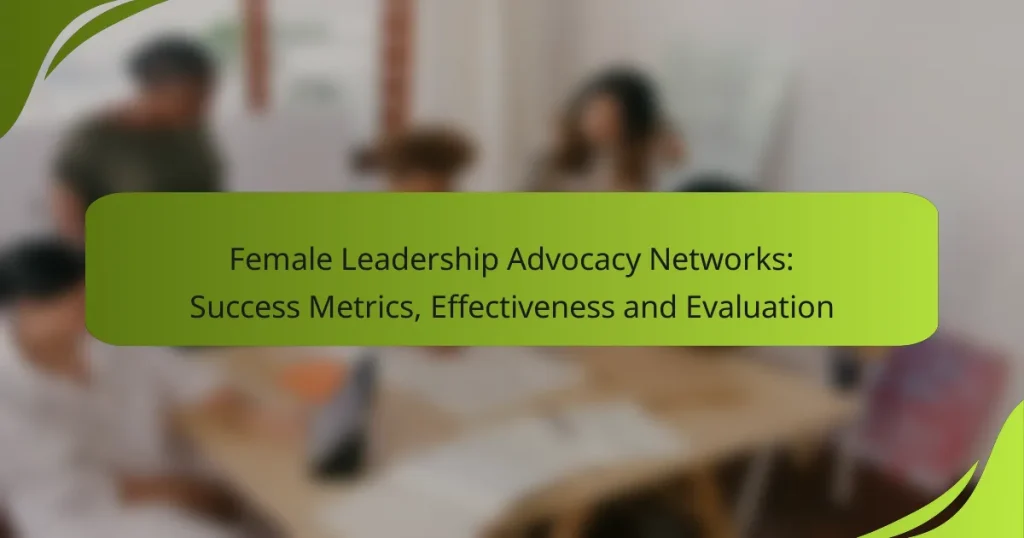Female leadership advocacy networks play a crucial role in promoting gender equity by measuring success through a blend of quantitative metrics and qualitative assessments. By fostering collaboration, mentorship, and resource sharing, these networks empower women leaders and enhance organizational culture. Their effectiveness is further amplified through strategic initiatives such as skill development workshops and networking events, which collectively contribute to the advancement of women in leadership roles.

How do female leadership advocacy networks measure success?
Female leadership advocacy networks measure success through a combination of quantitative metrics, qualitative assessments, benchmark comparisons, member feedback, and the impact on organizational culture. These methods provide a comprehensive view of effectiveness and areas for improvement.
Quantitative metrics
Quantitative metrics involve numerical data that can be easily measured and analyzed. Common metrics include membership growth rates, the number of events hosted, and participation levels in programs. For example, a network may track the percentage increase in female leaders within member organizations over a specific period.
Other relevant metrics could include the number of leadership positions attained by members or the amount of funding secured for initiatives. These figures help networks assess their reach and effectiveness in promoting female leadership.
Qualitative assessments
Qualitative assessments focus on the subjective experiences and perceptions of members. Surveys and interviews can provide insights into how participants feel about the support they receive and the overall impact of the network on their careers. This feedback is crucial for understanding the emotional and social aspects of leadership development.
Additionally, storytelling and case studies can illustrate personal journeys and successes, highlighting the network’s role in fostering leadership among women. These narratives can complement quantitative data by providing context and depth.
Benchmark comparisons
Benchmark comparisons involve evaluating a network’s performance against similar organizations or industry standards. This process helps identify best practices and areas where the network may lag. For instance, a network might compare its membership diversity against national averages or the performance of other advocacy groups.
By setting benchmarks, networks can establish realistic goals and track progress over time. This approach encourages continuous improvement and accountability within the organization.
Member feedback
Member feedback is essential for measuring success, as it reflects the experiences and satisfaction of participants. Regularly soliciting input through surveys or focus groups can help networks understand what members value most and where improvements are needed. This feedback loop fosters a sense of community and engagement.
Networks should prioritize acting on feedback to demonstrate responsiveness and commitment to member needs. Implementing changes based on this input can significantly enhance the overall effectiveness of the network.
Impact on organizational culture
The impact of female leadership advocacy networks on organizational culture is a critical success metric. This can be assessed by evaluating changes in workplace policies, diversity initiatives, and overall attitudes toward women in leadership roles. For example, a network may track the implementation of mentorship programs or flexible work arrangements that support female leaders.
Additionally, measuring cultural shifts can involve assessing employee engagement and retention rates among women in organizations influenced by the network. A positive change in culture often indicates the network’s effectiveness in promoting female leadership and fostering inclusive environments.

What are the most effective female leadership advocacy networks?
The most effective female leadership advocacy networks foster collaboration, mentorship, and resource sharing among women leaders. These networks provide platforms for skill development, networking opportunities, and advocacy for gender equity in leadership roles.
Lean In Circles
Lean In Circles are small groups of women who meet regularly to support each other in achieving their personal and professional goals. These circles create a safe space for sharing experiences, discussing challenges, and developing leadership skills through peer support.
To start a Lean In Circle, gather a group of women who share similar interests or goals. Set a regular meeting schedule and choose topics that resonate with the group. This structure encourages accountability and fosters a sense of community.
Women in Leadership Nexus
The Women in Leadership Nexus focuses on connecting women leaders across various industries to share insights and strategies. This network emphasizes collaboration and provides resources to help women navigate their careers effectively.
Members can participate in workshops, webinars, and networking events designed to enhance leadership skills. Engaging with this network can lead to valuable mentorship opportunities and partnerships that support career advancement.
National Women’s Business Council
The National Women’s Business Council (NWBC) is a federal advisory council that advocates for women entrepreneurs and business owners. It provides research, policy recommendations, and resources aimed at improving the economic landscape for women in business.
Engaging with the NWBC can help women business leaders access funding opportunities, training programs, and networking events. Staying informed about their initiatives can empower women to leverage available resources effectively.
Women Who Code
Women Who Code is a global nonprofit organization dedicated to inspiring women to excel in technology careers. The network offers coding resources, mentorship, and job opportunities specifically tailored for women in tech.
Joining Women Who Code can provide access to workshops, hackathons, and networking events that enhance technical skills and career prospects. This community fosters an inclusive environment where women can thrive in the tech industry.

What strategies enhance the effectiveness of these networks?
Effective female leadership advocacy networks utilize several strategies to maximize their impact. Key approaches include mentorship programs, networking events, skill development workshops, and partnerships with corporations, each playing a vital role in fostering leadership among women.
Mentorship programs
Mentorship programs are crucial for providing guidance and support to emerging female leaders. These programs typically pair experienced leaders with mentees, facilitating knowledge transfer and personal growth. Successful mentorship often includes regular meetings, goal-setting, and feedback sessions.
To enhance effectiveness, networks should consider structured mentorship frameworks that outline expectations and outcomes. For instance, a program might last six months to a year, with monthly check-ins to track progress and adjust goals as needed.
Networking events
Networking events create opportunities for women to connect, share experiences, and build professional relationships. These gatherings can range from informal meetups to large conferences, providing platforms for collaboration and idea exchange. Effective networking events often include a mix of structured activities and informal networking time.
To maximize engagement, consider hosting events that cater to specific interests or industries, ensuring relevance for attendees. Providing icebreakers or discussion prompts can also help facilitate connections among participants.
Skill development workshops
Skill development workshops focus on enhancing specific competencies that are essential for leadership roles. These workshops can cover a variety of topics, including negotiation skills, public speaking, and strategic planning. Tailoring content to the needs of participants increases the relevance and impact of these sessions.
Offering workshops in both in-person and online formats can accommodate different learning preferences and schedules. Additionally, incorporating hands-on activities and real-world scenarios can enhance retention and application of skills learned.
Partnerships with corporations
Partnerships with corporations can significantly amplify the reach and resources of female leadership advocacy networks. Collaborating with businesses allows for shared resources, sponsorship opportunities, and access to a wider audience. These partnerships can also lead to internship or job placement opportunities for network members.
When forming partnerships, it is essential to align goals and values with corporate partners to ensure mutual benefit. Regular evaluations of partnership outcomes can help refine strategies and enhance the effectiveness of collaborative efforts.

What evaluation frameworks are used for female leadership networks?
Evaluation frameworks for female leadership networks are structured methods that assess their effectiveness and impact. These frameworks help organizations measure outcomes, improve strategies, and ensure accountability in promoting female leadership.
Logic model framework
The logic model framework outlines the relationship between resources, activities, outputs, and outcomes in female leadership networks. It provides a visual representation that helps stakeholders understand how inputs lead to desired results. For example, a network may invest in training programs (inputs) that produce skilled leaders (outputs) and ultimately increase female representation in leadership roles (outcomes).
When implementing a logic model, ensure that each component is clearly defined and measurable. This clarity aids in tracking progress and making necessary adjustments. Regularly revisiting the model can help identify gaps and opportunities for improvement.
Results-based accountability
Results-based accountability (RBA) focuses on measuring the outcomes of female leadership networks to ensure they achieve their goals. This approach emphasizes the importance of data collection and analysis to evaluate success. For instance, tracking the number of women promoted to leadership positions after participating in a network can provide tangible evidence of impact.
To effectively utilize RBA, establish clear performance indicators and regularly review data to assess progress. Engaging stakeholders in this process can enhance transparency and foster a culture of accountability within the network.
Balanced scorecard approach
The balanced scorecard approach evaluates female leadership networks from multiple perspectives, including financial, customer, internal processes, and learning and growth. This comprehensive view allows organizations to align their strategies with their mission of promoting female leadership. For example, measuring participant satisfaction alongside leadership outcomes can provide a well-rounded assessment of the network’s effectiveness.
When adopting a balanced scorecard, ensure that each perspective is represented with relevant metrics. Regularly updating these metrics can help organizations adapt to changing needs and enhance their strategies for supporting female leaders.

What challenges do female leadership advocacy networks face?
Female leadership advocacy networks encounter several significant challenges that can hinder their effectiveness. Key issues include funding limitations, member engagement issues, and the need for strategic evaluation of their impact.
Funding limitations
Funding limitations are a critical challenge for female leadership advocacy networks, often restricting their ability to implement programs and initiatives. Many networks rely on grants, sponsorships, or membership fees, which can fluctuate based on economic conditions and donor priorities.
To address funding challenges, networks should diversify their funding sources. This could include seeking partnerships with corporations, applying for government grants, or organizing fundraising events. Establishing a clear budget and financial plan can also help prioritize spending and maximize available resources.
Member engagement issues
Member engagement issues can significantly impact the effectiveness of female leadership advocacy networks. Low participation rates in events and initiatives may stem from a lack of awareness, perceived value, or competing commitments among members.
To enhance engagement, networks should actively communicate the benefits of participation and create opportunities for members to contribute. Regular surveys can help identify member interests and preferences, allowing for tailored programming. Additionally, fostering a sense of community through networking events and mentorship programs can strengthen member connections and commitment.


